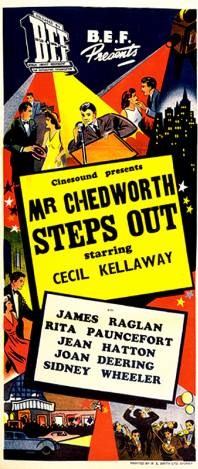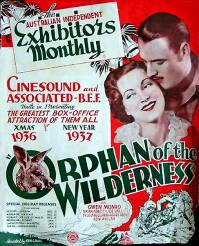Related Research Articles

Kenneth George Hall was an Australian film producer and director, considered one of the most important figures in the history of the Australian film industry. He was the first Australian to win an Academy Award.

Ronald Grant Taylor was an English-Australian actor best known as the abrasive General Henderson in the Gerry Anderson science fiction series UFO and for his lead role in Forty Thousand Horsemen (1940).

Cinesound Productions Pty Ltd was an Australian feature film production company. Established in June 1931, Cinesound developed out of a group of companies centred on Greater Union Theatres that covered all facets of the film process, from production to distribution and exhibition. Cinesound Productions established a film studio as a subsidiary of Greater Union Theatres Pty Ltd based on the Hollywood model. The first production was On Our Selection (1932), which was an enormous financial success.
Dad and Dave Come to Town is a 1938 Australian comedy film directed by Ken G. Hall, the third in the 'Dad and Dave' comedy series starring Bert Bailey. It was the feature film debut of Peter Finch and is one of the best known Australian films of the 1930s.

Mr. Chedworth Steps Out is a 1939 Australian comedy film directed by Ken G. Hall starring Cecil Kellaway. Kellaway returned to Australia from Hollywood to make the film, which features an early screen appearance by Peter Finch.

On Our Selection is a 1932 comedy based on the Dad and Dave stories by Steele Rudd. These had been turned into a popular play by Bert Bailey and Edmund Duggan in 1912, which formed the basis for the screenplay. Bailey repeats his stage role as Dad Rudd. He also wrote the script with director Ken G. Hall.
The Squatter's Daughter is a 1933 Australian melodrama directed by Ken G. Hall and starring Jocelyn Howarth. One of the most popular Australian films of the 1930s, it is based on a 1907 play by Bert Bailey and Edmund Duggan which had been previously adapted to the screen in 1910.
The Silence of Dean Maitland is a 1934 Australian film directed by Ken G. Hall, and based on Maxwell Gray's 1886 novel of the same name. It was one of the most popular Australian films of the 1930s.

Strike Me Lucky is a 1934 Australian comedy musical film starring popular stage comic vaudevillian Roy Rene in his first and only film. It was the fourth feature film from Cinesound Productions but proved a box office disappointment. Director Ken G. Hall claimed it was the only one of his features not to go into profit within a few years of release, although the film eventually covered costs.

Grandad Rudd is a 1935 comedy featuring the Dad and Dave characters created by Steele Rudd and based on a play by Rudd. It was a sequel to On Our Selection, and was later followed by Dad and Dave Come to Town and Dad Rudd, MP.

Orphan of the Wilderness is a 1936 Australian feature film from director Ken G. Hall about the adventures of a boxing kangaroo. It starred Brian Abbot who disappeared at sea not long after filming completed.
It Isn't Done is a 1937 Australian comedy film about a grazier who inherits a barony in England.
Gone to the Dogs is a 1939 musical comedy vehicle starring George Wallace. It was the second of two films he made for director Ken G. Hall, the first being Let George Do It (1938).

Dad Rudd, M.P. is a 1940 comedy that was the last of four films made by Ken G. Hall starring Bert Bailey as Dad Rudd. It was the last feature film directed by Hall prior to the war and the last made by Cinesound Productions, Bert Bailey and Frank Harvey.
Come Up Smiling is a 1939 Australian comedy film starring popular American stage comedian Will Mahoney and his wife Evie Hayes. It was the only feature from Cinesound Productions not directed by Ken G. Hall.
100,000 Cobbers is a 1942 dramatised documentary made by director Ken G. Hall for the Australian Department of Information during World War II to boost recruitment into the armed forces. Grant Taylor, Joe Valli and Shirley Ann Richards play fictitious characters.
South West Pacific is a 1943 propaganda short Australian film directed by Ken G. Hall which focuses on Australia as the main Allied base in the South West Pacific area. Actors depict a cross section of Australians involved in the war effort.
White Death is a 1936 Australian film directed by Edwin G. Bowen and starring Zane Grey as himself. He filmed it during a fishing expedition to Australia and it marked the first time he had played a leading role in a film.
Pagewood Studios was a film studio in Sydney, Australia, that was used to make Australian, British and Hollywood films for 20 years.
John Fleeting, real name Claude Stuart Fleeting, was an Australian actor best known for his film appearances for Ken G. Hall.
References
- ↑ "Advertising". The Sydney Morning Herald . 23 February 1931. p. 5. Retrieved 12 February 2015– via National Library of Australia.
- ↑ "EMPIRE TALKIES". The Port Macquarie News and Hastings River Advocate . NSW. 29 August 1931. p. 4. Retrieved 12 February 2015– via National Library of Australia.
- 1 2 "NEW FILMS". The Sydney Morning Herald . 2 March 1931. p. 5. Retrieved 12 February 2015– via National Library of Australia.
- 1 2 3 Ken G. Hall, Directed by Ken G. Hall, Lansdowne Press, 1977 p 55.
- ↑ "Filming North Australia". The Sydney Mail . NSW. 1 April 1931. p. 10. Retrieved 12 February 2015– via National Library of Australia.
- ↑ "At the Pictures". The Sydney Mail . NSW. 4 March 1931. p. 16. Retrieved 12 February 2015– via National Library of Australia.
- ↑ "ENTERTAINMENTS TIVOLI THEATRE". The Brisbane Courier . 31 March 1931. p. 13. Retrieved 12 February 2015– via National Library of Australia.
- ↑ ""CITY OF SONG" STAR HAILED AS NEW CARUSO". The News (HOME ed.). Adelaide. 11 September 1931. p. 4. Retrieved 12 February 2015– via National Library of Australia.